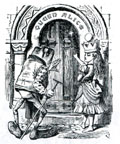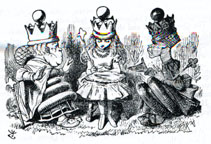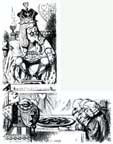In Alice in Wonderland, Lewis Carroll brings to life a series of fanciful and complex dreamlike scenes. Much in Wonderland simply cannot be explained. Carroll illustrates his characters as wild animals, chess pieces, and mythical creatures. He advances or stalls the story's plot on a whim and without much regard to cause or effect. Therefore, the story's structure often confuses and disorients its readers.
However, the beauty of the story resides in these very feelings of confusion. The immersive and disorienting feeling that the novel evokes not only shows the reader a glimpse of how a child views the world but also forces the reader to question their own perception of their world and, more specifically, what words in spoken language really mean.
Characters in the novel repeatedly correct Alice on her use of language. For example, Alice encounters the White King after leaving Humpty Dumpty. The King explains that he has sent all his men and most of his horses, as promised, to aid Humpty Dumpty after his fall.
"Four thousand two hundred and seven, that's the exact number," the King said, referring to his book. "I couldn't sent all the horses . . . And I havn't sent the two Messengers, either. They're both gone to the town. Just look along the road, and tell me if you can see either of them."
"I see nobody on the road," said Alice.
"I only wish I had such eyes," the king remarked in a fretful tone. "To be able to see Nobody! And at that distance too! Why, it's as much as I can do to see real people, by this light!" (170)
Here, the King takes what Alice says as literal and marvels at her apparent ability to see imaginary people. He is confused again while they talk about the King's two messengers.
"The other Messenger's called Hatta. I must have two, you know to come and go. One to come, and one to go."
"I beg your pardon?" said Alice.
"It isn't respectable to beg," said the King. (171)
Similarly, later when Alive, after being crowned Queen, comes upon a doorway marked "Queen Alice," she begins to knock heavily on the door. This noise awakens a nearby Frog who approaches Alice.

"What is it, now?" the Frog said in a deep hoarse whisper.
Alice turned round, ready to find fault with anybody. "Where's the servant whose business it is to answer the door?" she began angrily.
"Which door?" said the Frog.
Alice almost stamped with irritation at the slow drawl in which he spoke. "This door, of course!"
The Frog looked at the door with his large dull eyes for a minute: then he went nearer and rubbed it with his thumb, as if he were trying whether the paint would come off: then he looked at Alice.
"To answer the door?" he said "What's it been asking of?" He was so hoarse that Alice could scarcely hear him.
"I don't know what you mean," she said.
"I speaks English, doesn't I?" the Frog went on. "Or are you deaf? What did it ask you?"
"Nothing!" Alice said impatiently. "I've been knocking at it!"
"Shouldn't do that-shouldn't do that-" the Frog muttered. "Wexes it, you know." Then he went up and gave the door a kick with one of his great feet. "You let it alone," he panted out, as he hobbled back to his tree, "and it'll let you alone, you know." (199)
Not only are these encounters tremendously funny, but they also illustrate the sharp contrast between what is literal and what is illusion in Alice in Wonderland. Again, Carroll paints almost all of the characters and events in the story as fantastic and the situations that Alice encounters as ridiculous and nonsensical. Yet, time and again, the creatures of Wonderland interpret Alice's statements as completely literal. The sharp contrast between the irrationality of the situation and the rationality behind each character's treatment of Alice's language startles the reader and leads them to re-read each of Alice's misinterpreted statements and view them for they literally mean. This process forces the reader to question our own use of language and expression (which, of course, Alice simply mimics) and how we often say something that we completely do not mean.
Questions
Why do you think Carroll has the creatures of Wonderland repeatedly question Alice on her use of language and sayings? Do you agree that he is trying to make his readers question his and their use of language? Is it simply for comedic relief?
We repeatedly see creatures in Wonderland either reciting poetry to Alice or asking her to recite some herself. What importance does song and poetry play in Alice in Wonderland? Particularly the inclusion of "Jabberwocky" in the beginning of Through the Looking-Glass? and "The Walrus and the Carpenter" in the Tweedledum and Tweedledee chapter.
The brief biography of George Macdonald on the Victorian Web says that "praise of the Macdonald children for his manuscripts was what induced Lewis Carroll to publish his work." Macdonald and Carroll, due to the fact that they were writing similar fiction at similar times, must certainly have been in contact with each other throughout their careers. How does Macdonald's Phantastes and Carroll's Alice in Wonderland compare? Are Anodos and Alice similar characters? Do they go through similar trials?
Directed at Professor Landow; did both writers have similar goals for their stories? Similar audiences?


In both sections of the novel, we see various portrayals of royalty, mainly the King and Queen of Hearts in Alice's Adventure in Wonderland and the Red and White king and queen in Through the Looking-Glass. None of these characters portray a particularly flattering image. Might Carroll be trying to comment on the English Crown? Or could these simply be more comic characters in his fantastic novel?
Last modified 13 March 2009